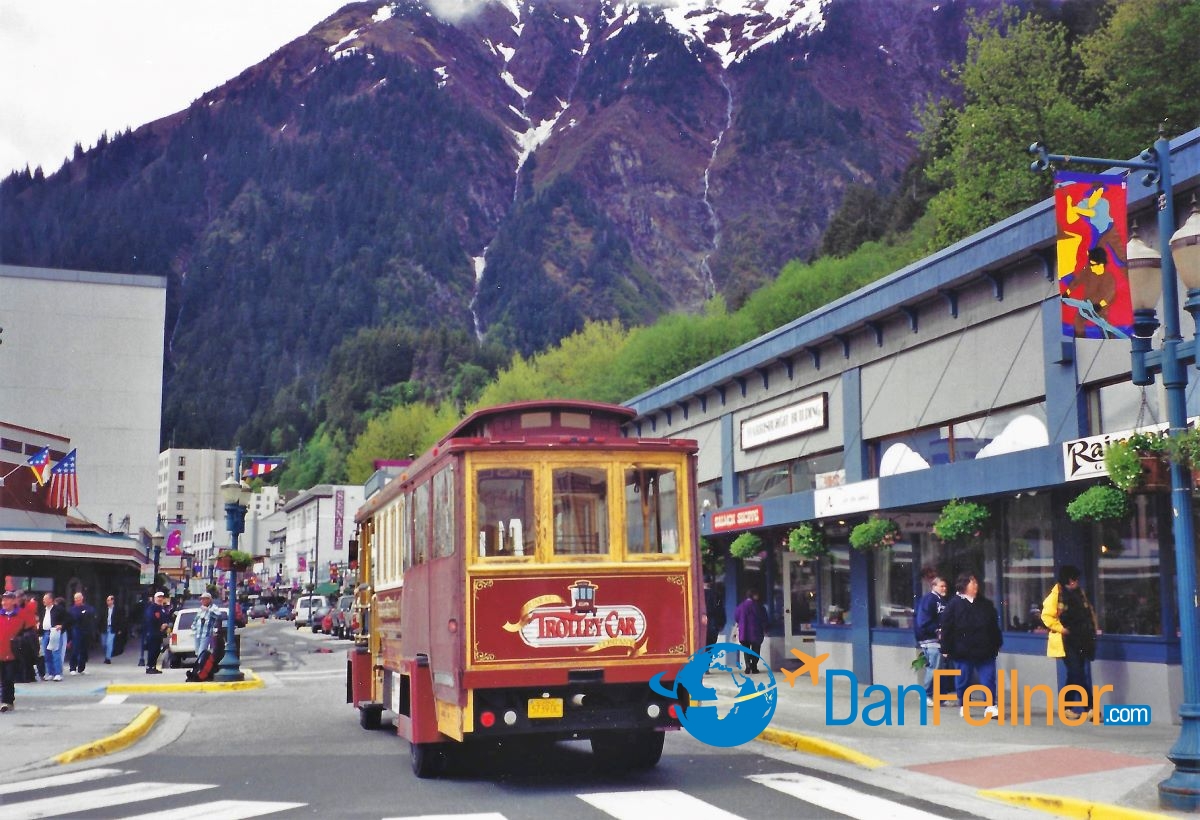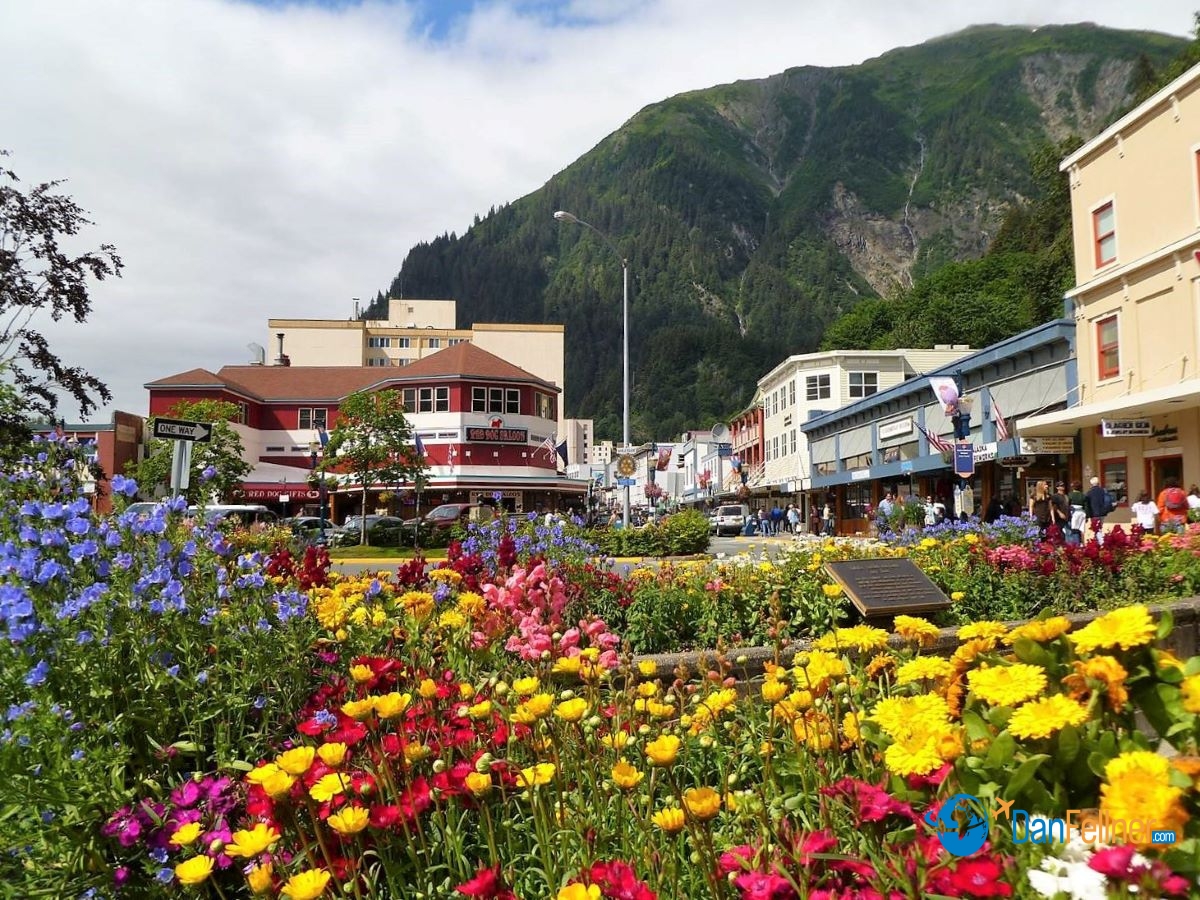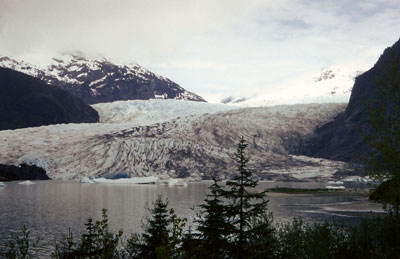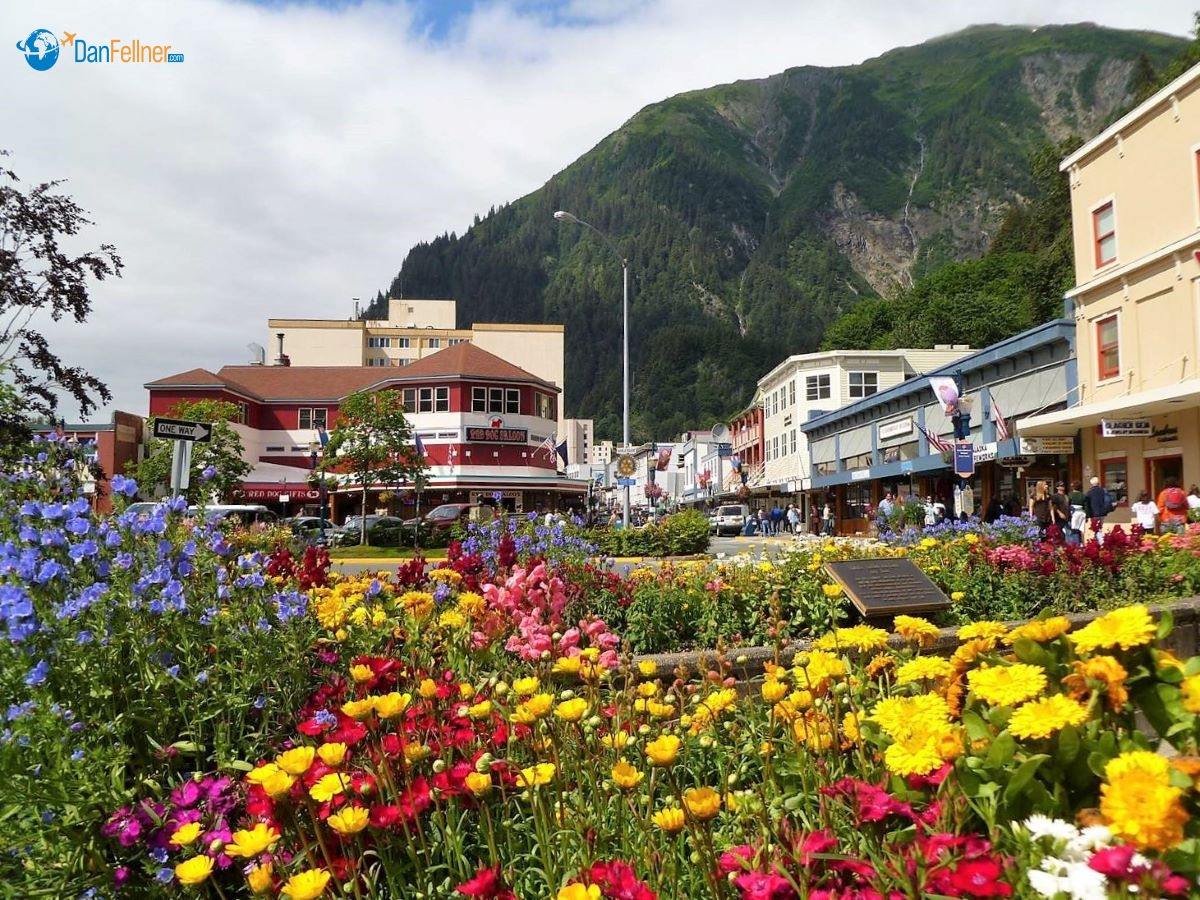Popular stop on Inside Passage cruise offers glaciers, wildlife and stunning scenery
East Valley Tribune – October 10, 1999
JUNEAU, Alaska – While we gape at a pair of bald eagles perched on a tree lining the road, the guide on our tour bus directs our attention to a nondescript building on the right.
“It’s the most dangerous school in America,” she says of Juneau-Douglas High School. Guns and gangs posing problems in such a charming and quaint city as Juneau, Alaska, we wonder?

A trolley car gives passengers a lift in downtown Juneau, Alaska.
No, she explains, the school must contend with threats of an entirely different nature – avalanches, earthquakes and tidal waves.
Such catastrophes are relatively rare in Juneau. Indeed, visiting what is arguably the nation’s prettiest capital city and most interesting cruise-ship stop on Alaska’s Inside Passage is well worth the risk.
Juneau is the proverbial “can’t get there from here” town. Surrounded by water and impenetrable mountains and forests, it’s the only state capital in the country that can’t be reached by road from anywhere else in the state.
Thus, Juneau is the answer to one of the most frequently asked bar trivia questions.
It’s also a cruise ship mecca. More than half a million big-boat passengers arrive in Juneau each summer. It’s not uncommon to see five or more liners docked in the city’s scenic downtown harbor, nestled on the Gastineau Channel beneath a pair of nearly 4,000-foot peaks — Mount Roberts and Mount Juneau.
Visitors like what they find. A Los Angeles Times readers’ poll ranked Juneau the fifth best cruise destination in the world. The city of 30,000 residents offers a unique blend of colorful history, politics and scenery, including the world’s only “drive-in” glacier.
Add to the mix the obligatory bevy of cruise-port shopping opportunities – yes, there’s even a Little Switzerland store — and it’s easy to see Juneau emerging as the St. Thomas of the Inside Passage.
Juneau has the distinction of being the first town founded in Alaska after the U.S. purchased the territory from Russia. In 1880, a Tlingit chief named Kowee led prospectors Joe Juneau and Richard Harris to gold in a creek off the Gastineau Channel. The gold rush was on.

Summer flowers bloom in downtown Juneau, Alaska.
Two Juneau museums capture the flavor of the town’s colorful history as a mining town – the Last Chance Mining Museum and Juneau-Douglas City Museum, the latter of which specializes in displays for children.
Gold enthusiasts also can go panning for riches near the ruins of an old mine. You get to keep what you pull out of the river, but don’t quit your day job – they sell vials of water containing as much gold powder as you’re likely to scoop out of your pan for $3 at local souvenir shops.
For a more adult-oriented taste of frontier Alaska, check out the Red Dog Saloon. It’s got sawdust on the floor, locally brewed Alaskan Amber beer on tap, and one of Wyatt Earp’s pistols on the wall. On his way to Nome in 1900, he stopped in Juneau, where the local authorities asked him to check his gun. He left town without claiming it.
Juneau’s gold mining era ended in the 1940s. By then, though, the town had shifted gears from prospecting to politics.
The city became Alaska’s territorial capital in 1906 and has hung on to the state’s seat of government ever since, although there have been several unsuccessful attempts to move the capital to a more accessible and centrally located city.
Today, government is Juneau’s biggest industry, accounting for 57 percent of all wages. Tourism is second, followed by commercial fishing.
Piano-playing political satirist Mark Russell described the State Capitol Building as looking like “any Midwestern public works building.” He was right.
Despite its boring exterior, the inside has some fascinating old photos and free tours are offered throughout the day. If nothing else, take a look at a replica of the fractured Liberty Bell out front. Whoever did the engraving fractured the spelling of the state that houses the original (“Pensylvania”).
Just down the street is the Governor’s Mansion. Built in 1912, it could pass for a southern plantation house, if it weren’t for the huge totem pole on the side. Interestingly, the pole tells the story of the origin of the mosquito, which some refer to as Alaska’s “state bird” during the summer months.
The building still houses the state’s governor. Tony Knowles and his family host a tea here every Christmas and the guest list includes more than 600,000 people – all the state’s residents.
For an architectural change of pace, stroll over to the St. Nicholas Russian Orthodox Church, the oldest religious building in southeast Alaska. Built in 1894 in Siberia, this small octagonal structure with a gold onion-dome is a reminder of the strong Russian presence in 19th-century Alaska. It was refurbished in the 1970s and is a national historic landmark.
But Juneau’s most popular attraction is not man-made.

Mendenhall Glacier near Juneau is the most visited glacier in the world.
Located about 13 miles from downtown is the most visited glacier in the world, Mendenhall Glacier.
Mendenhall stretches 12 miles long and one-and-a-half miles wide. It’s got a bluish tint, common for glaciers, which absorb all colors of the spectrum except for blue, giving the ice its bluish appearance.
There may be prettier glaciers in Alaska, but none that are as accessible. A tour bus or cab will drop you off at a recently renovated U.S. Forest Service observatory. From there, a short walk takes you to within a quarter-mile of the glacier.
For those with more time and money, you can see the glacier by plane, helicopter, river raft, kayak or bicycle tour. Some excursions even throw in a king-salmon bake for those who get hungry watching the ice melt.
Since the mid-1700s, the glacier has been retreating about 70 feet each year, creating a flatland where they’ve put a nine-hole golf course the locals call the “worst golf course with the best view in America.” At high tide, it becomes an eight-hole course.
Another popular Juneau attraction is the Mount Roberts Tramway, located right next to the cruise-ship dock. A six-minute ride takes you to the top of the peak for a wonderful panoramic view of the town and its surroundings. There’s a museum and nature trails. It’s pricey, though — $19.75 for adults – and don’t bother going if the weather isn’t clear.
The weather isn’t clear most of the time in Juneau — it rains or snows an average of 321 days a year. Bring an umbrella, although it will identify you as a tourist. Alaskans are known for shunning umbrellas, partly because the rain here is usually accompanied by strong winds.
And bring your binoculars. Aside from bald eagles, plenty of other wildlife, including humpback whales and brown and black bears, can be spotted in the vicinity.
Sadly, most visitors to Juneau get to spend all of 12 hours here before their cruise ships depart for the next port-of-call. Like a trip to the midnight buffet, you’ll leave satisfied but wondering just a bit about all the treats you didn’t sample.
© 2009 Dan Fellner



